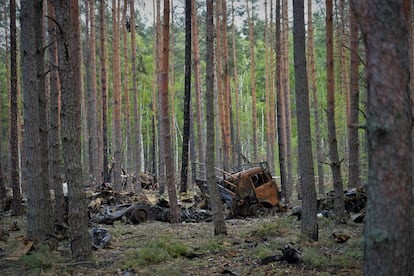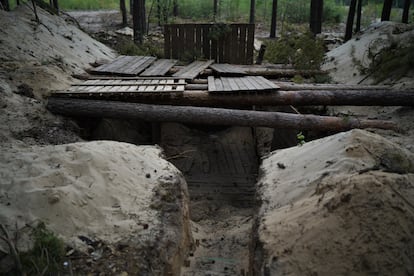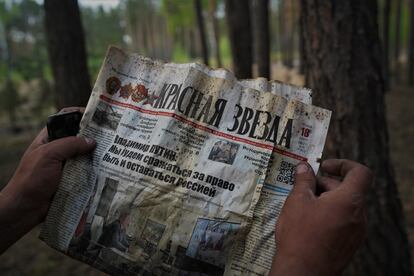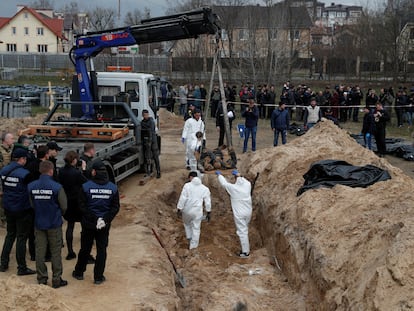Ground zero of one of the Russian army’s greatest defeats in Ukraine
The March 27 attack against Moscow forces in a forest camp near Bucha destroyed nearly everything within a 300-meter radius. Two months later, the wreckage is still visible

What starts as a simple walk through the countryside quickly turns into a scene out of Dante’s Infierno. While it may seem like just another of the many forests that surround Kyiv, it is the site of one of the Russian army’s greatest defeats in Ukraine. Not only did the Kremlin’s troops fail to take the Ukrainian capital after the February 24 invasion, but on the night of March 27, they were the victims of a fierce counterattack. At 11pm, according to some locals, the local Ukrainian army destroyed part of the huge camp that the invaders had set up between the towns of Bucha and Borodianka.
The bombing was so intense it wiped out everything within a 200- to 300-meter radius. There is no information on how many Russian soldiers were deployed at the camp, but based on its size – it spread over numerous hectares – it could have been home to thousands of troops. None of the locals in the area know how many of the soldiers died in the shelling or in the explosions caused by the strike. It seems that corpses are the only thing authorities have taken away.
At the beginning of the track leading to the site, there are traces of civilization. One might think it is trash left behind by campers: a boot, a piece of plastic, a piece of clothing, food scraps... A few hundred meters ahead, the scene changes and it’s obvious that no camper could have been responsible for such wreckage. It’s also clear this is no place for a leisurely stroll. Several signs nailed to the edge of the path warn of the possible presence of mines.
Huge trenches the size of garages begin to appear one after the other. The ramps leading into them suggest that they were used to camouflage vehicles. Some of these holes, covered with logs and branches, have been turned into underground bunkers. Some still even have sleeping mats in them. There are also hut-like structures, made from branches and tarpaulin, which look like they could have been used for toilets. There are more clothes and boots, makeshift clotheslines, green wooden and metal boxes. These contain ammunition. Through the pine trees, the first burned-out military vehicle appears. It’s difficult to conceive what nature is hiding ahead.

There is no trace of human life, only death. Two sticks tied together to make a cross are placed over a grave. “It belongs to a Russian soldier,” says Slava, a local who is acting as a guide. Further on, there are six empty graves next to what appear to be the remains of other makeshift crosses. “These were Ukrainians and they were dug up,” he adds. These victims got a second, less undignified farewell. After a while, Slava says that the worst of the destruction is coming up. Slava takes a certain pride in being able to show proof of the Russian defeat, announcing it as though telling tourists at the cathedral of Notre Dame that they were about to see the main attraction, the temple’s famous gargoyles.
But first, there are washing machines, television sets and other household appliances that have been devoured by the flames. “These are the remains of what Russians were stealing from houses and left behind,” says Slava with a touch of hatred. Other locals from villages under Russian occupation also say that Russian troops looted their homes, sometimes even robbing clothes to combat the harsh winter weather and morsels of food to drive away their hunger.
Food, however, did reach this forest camp. Remnants of individual rations with the Russian Army logo on the package can be seen strewn about. There is even a copy of Russia’s official government newspaper Krasnaya Zvezda or Red Star from Friday, March 18. “Vladimir Putin: We will fight for the right to be and continue being Russia,” is the main headline on the front page, which appears next to a photograph of President Vladimir Putin. Other articles in the newspaper speak of “Goebbels-style” Western fabrications and the “historical roots of Ukrainian Nazism.”
Up ahead, the attack has left a circular clearing in the woods. Some of the trees are burned out, others are split in half or splintered almost artistically. And just a short walk on, the scene turns into something from a war movie.

Strewn across the forest are the charred remains of dozens of trucks and other vehicles. Some are a hunk of scrap metal. Others are more recognizable, but have been hit so hard by the shelling that light passes through them like water through a sieve. Ammunition and shells of all calibers are scattered across the ground, as well as documentation that miraculously escaped the flames, the remains of uniforms, burnt metal trunks...
Russian forces had razed this area to the ground and occupied it for a month. When Putin failed to seize control of Kyiv, the troops prepared to withdraw at the end of March. But a bitter farewell awaited them. It was in the midst of these preparations, on March 27, when the Russian troops were met with a fierce counterattack. According to Slava, it lit up the night as if it were daytime.
Tu suscripción se está usando en otro dispositivo
¿Quieres añadir otro usuario a tu suscripción?
Si continúas leyendo en este dispositivo, no se podrá leer en el otro.
FlechaTu suscripción se está usando en otro dispositivo y solo puedes acceder a EL PAÍS desde un dispositivo a la vez.
Si quieres compartir tu cuenta, cambia tu suscripción a la modalidad Premium, así podrás añadir otro usuario. Cada uno accederá con su propia cuenta de email, lo que os permitirá personalizar vuestra experiencia en EL PAÍS.
¿Tienes una suscripción de empresa? Accede aquí para contratar más cuentas.
En el caso de no saber quién está usando tu cuenta, te recomendamos cambiar tu contraseña aquí.
Si decides continuar compartiendo tu cuenta, este mensaje se mostrará en tu dispositivo y en el de la otra persona que está usando tu cuenta de forma indefinida, afectando a tu experiencia de lectura. Puedes consultar aquí los términos y condiciones de la suscripción digital.
More information
Ukraine war: The first safe stop after the siege

Ukraine: How to prove a war crime
Últimas noticias
Tiger Woods turns 50: Will he continue playing on the PGA Tour or take a back seat?
The surreal journey of James Nnaji, the Barcelona youth player selected in the NBA Draft who ended up in the NCAA
Trump claims peace in Ukraine is near, but Moscow suggests otherwise
A survivor’s account of the Interoceanic Train accident: ‘We were scared because of the speed on the curve’
Most viewed
- Oona Chaplin: ‘I told James Cameron that I was living in a treehouse and starting a permaculture project with a friend’
- Reinhard Genzel, Nobel laureate in physics: ‘One-minute videos will never give you the truth’
- Why the price of coffee has skyrocketed: from Brazilian plantations to specialty coffee houses
- Pablo Escobar’s hippos: A serious environmental problem, 40 years on
- Chevy Chase, the beloved comedian who was a monster off camera: ‘Not everyone hated him, just the people who’ve worked with him’









































